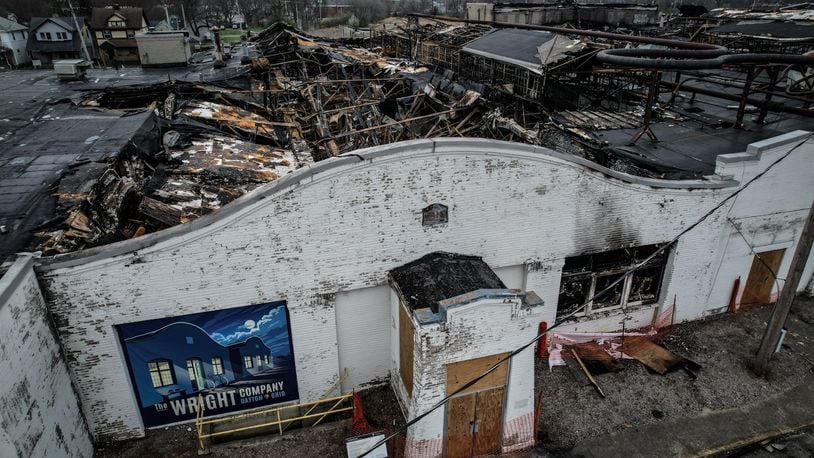“The National Park Service is waiting on the structural analysis being contracted by the city of Dayton,” said Kendell Thompson, superintendent of the Dayton Aviation Heritage National Historical Park. “It would be difficult to speculate on the property acquisition without the full knowledge as to the extent of damage or the repairs necessary to make the structures safe and viable for park or visitor use.”
U.S. Rep. Mike Turner, R-Dayton, said the park service still has a statutory obligation to acquire the site. He does not believe the fire caused roadblocks that cannot be overcome.
“I didn’t see any of the items identified (by the park service) as unaccomplishable or an impediment to the National Park Service operating at the site,” said Turner, who helped secure $4 million in Congressional earmarks to help revitalize the factory property.
Credit: Jim Noelker
Credit: Jim Noelker
Burned buildings
The Wright company factory property in West Dayton caught fire on March 26, 2023.
The blaze caused considerable damage to multiple vacant hangar buildings located near Abbey Avenue and West Third Street that were once home to the Wright brothers’ airplane factory.
The city of Dayton owns the property and wants to see it redeveloped into a mix of new uses. One proposed use is for the National Park Service to turn two historic buildings (hangars 1 and 2) into an aviation museum and tourist destination.
The National Park Service in the past said it hoped to buy and rehab buildings 1 and 2 and put visitor services inside, plus other uses.
The museum likely would focus on how the Wright company factory played a major role in the birth of the American aviation industry. Exhibits possibly could include replica Wright company aircraft and machinery, according to a general management plan amendment to the Dayton Aviation Heritage National Historical Park from May 2022.
That sale, however, still has not happened.
Last summer, Rep. Turner and U.S. Sen. Sherrod Brown (D-Ohio) sent a letter to the director of the National Park Service urging the agency to “fulfill its statutory requirement” and purchase the two historic hangar buildings.
Their 2023 letter said Congress added the Wright company factory site to the boundaries of the Dayton Aviation Heritage National Historical Park in 2009 and appropriated $450,000 for it in 2018, so the park service must acquire the factory property.
Brown and Turner said the five-year delay in the purchase of the property is unacceptable, and it’s possible the devastating fire could have been avoided if the park service had already acquired the property. They asked the park service to complete the acquisition within one year.
Herbert Frost, director of the National Park Service’s Midwest region, sent a response letter late last year that said the potential acquisition of the factory site has been complicated by environmental and legal issues.
He wrote that it was unclear how much of the historic fabric of the buildings is still intact.
Loss of structural integrity of the properties, potential damage to contaminated surfaces, possible new safety hazards and other factors would change the park service’s ability to use the property for visitor services and administrative purposes, Frost’s letter states.
After a post-fire assessment is complete, the park service plans to complete a full reevaluation of the “prospective” acquisition of the property, Frost said.
Thompson, superintendent of the Dayton Aviation Heritage National Historical Park, said the park service had made considerable progress toward acquisition before the fire, which included doing environmental studies and surveys and initiating the appraisal process.
But Thompson said decisions about the acquisition of the properties cannot be made until they understand current conditions, post-fire. He said the park does not have a deadline for when these decisions would need to be made.
Rep. Turner last week told the Dayton Daily News that he and Sen. Brown have been pushing the park service to expedite its acquisition of the site, even though the fire complicated matters and the agency indicated it has a fairly lengthy to-do list.
Turner said the $4 million he helped secure in congressionally directed spending (earmarks) will help the city of Dayton prepare the site for redevelopment and transfer to the park service. He said the funding should be sufficient to “get this project moving.”
A spokesperson for Sen. Brown said he will continue to work with Turner to ensure the park service holds up its end of the deal.
“Sen. Brown will continue to hold the National Park Service accountable to fulfill its statutory requirement by purchasing the Wright Company factory buildings,” the spokesperson said.
In addition to money from the federal earmark, the city of Dayton also has said it will invest about $3.8 million of its COVID relief funds into the property, and the project also was awarded about $1.4 million in state capital funds.
The city did not immediately respond to this newspaper’s questions about the Wright factory site.
Mackensie Wittmer, executive director of the National Aviation Heritage Alliance, said her not-for-profit organization tried to get cost estimates for a structural analysis, to see if the alliance might be able to help. But she said the alliance did not get a response from the city or the park service.
“The National Aviation Heritage Alliance’s No. 1 concern is that the historical facade falls down before the city and the National Park Service agree on a path forward,” Wittmer said.
About the Author
